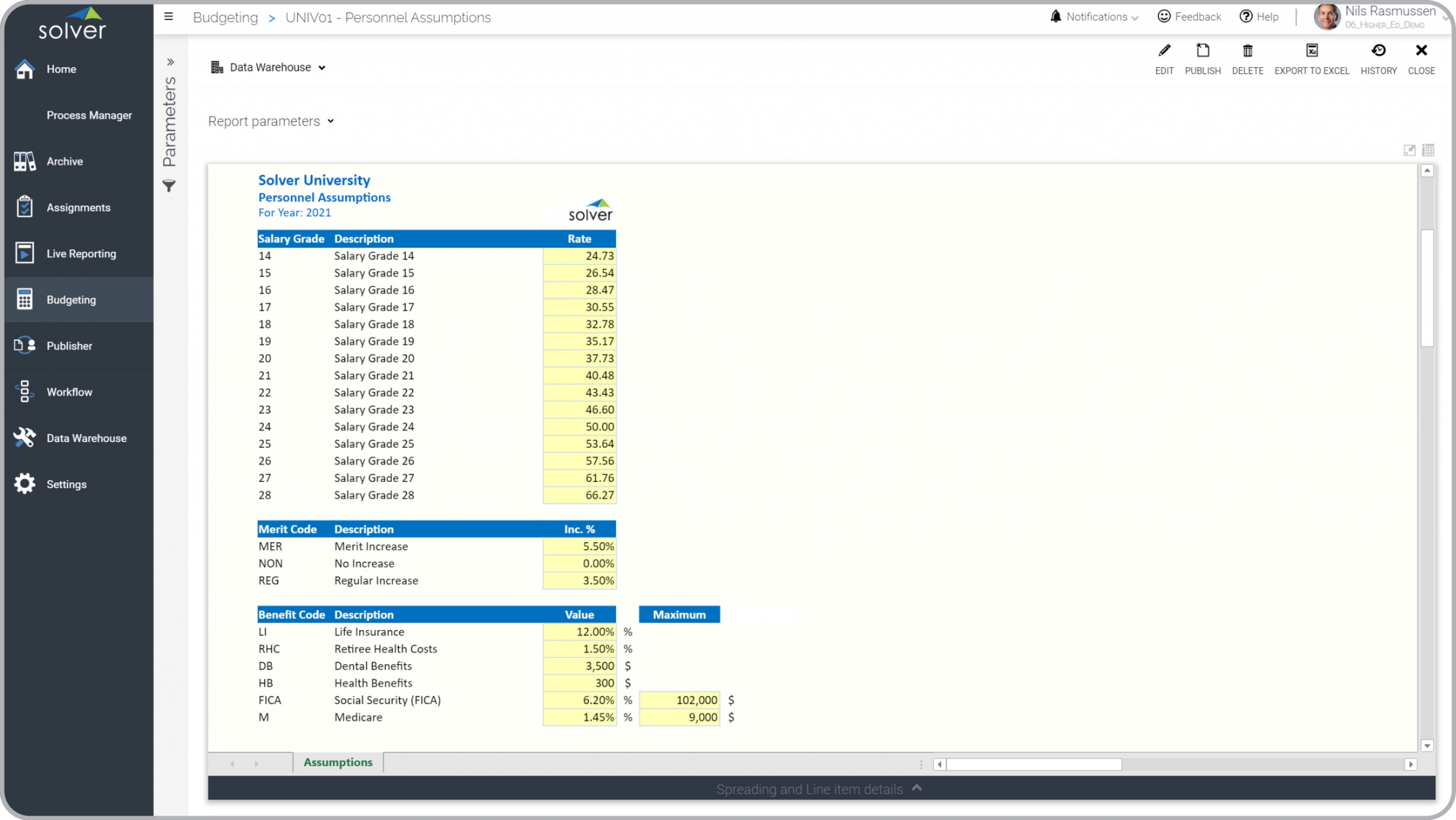Higher Education Budgeting - Personnel Assumptions
What
are
Personnel Assumptions in a Higher Education Budget Model
? Employee-focused Assumption Forms are considered driver-based templates and are often used by budget managers to input various salary and benefit rates that will be used in the personnel payroll budget. Key functionality in this type of form provides input of any type of pre-determined cost or rate that is needed for the detailed personnel budget. This can include rates per salary grade, merit increases, Medicare, insurance, and other benefits. You will find an example of this type of form below.
Purpose of
Personnel Assumption Forms Universities and colleges use Personnel Assumption Forms to enter key personnel cost drivers before the detailed employee budget is entered. When used as part of good business practices in a Budgeting and Planning department, an institution can improve its employee budget process, as well as, reduce the chances that personnel expenses are not updated if underlying drivers change after the planning process has commenced.
Personnel Assumption Form
Example Here is an example of a University Personnel Assumption Form. [caption id="" align="alignnone" width="2560"]
 Higher Education Budgeting - Personnel Assumptions Example[/caption] You can find hundreds of additional examples
here.
Who Uses This Type of
Form
? The typical users of this type of form are: Budget Officers and HR Managers.
Other
Form
s Often Used in Conjunction with
Personnel Assumption Forms Progressive Budgeting and Planning Departments sometimes use several different Personnel Assumption Forms, along with payroll, capex, operating expense and revenue templates, in addition to other management and control tools.
Where Does the Data for Analysis Originate From? The Actual (historical transactions) data typically comes from enterprise resource planning (ERP) systems like: Microsoft Dynamics 365 (D365) Finance, Microsoft Dynamics 365 Business Central (D365 BC), Microsoft Dynamics AX, Microsoft Dynamics NAV, Microsoft Dynamics GP, Microsoft Dynamics SL, Sage Intacct, Sage 100, Sage 300, Sage 500, Sage X3, SAP Business One, SAP ByDesign, Acumatica, Netsuite and others. In analyses where budgets or forecasts are used, the planning data most often originates from in-house Excel spreadsheet models or from professional corporate performance management (CPM/EPM) solutions.
What Tools are Typically used for Reporting, Planning and Dashboards? Examples of business software used with the data and ERPs mentioned above are:
Higher Education Budgeting - Personnel Assumptions Example[/caption] You can find hundreds of additional examples
here.
Who Uses This Type of
Form
? The typical users of this type of form are: Budget Officers and HR Managers.
Other
Form
s Often Used in Conjunction with
Personnel Assumption Forms Progressive Budgeting and Planning Departments sometimes use several different Personnel Assumption Forms, along with payroll, capex, operating expense and revenue templates, in addition to other management and control tools.
Where Does the Data for Analysis Originate From? The Actual (historical transactions) data typically comes from enterprise resource planning (ERP) systems like: Microsoft Dynamics 365 (D365) Finance, Microsoft Dynamics 365 Business Central (D365 BC), Microsoft Dynamics AX, Microsoft Dynamics NAV, Microsoft Dynamics GP, Microsoft Dynamics SL, Sage Intacct, Sage 100, Sage 300, Sage 500, Sage X3, SAP Business One, SAP ByDesign, Acumatica, Netsuite and others. In analyses where budgets or forecasts are used, the planning data most often originates from in-house Excel spreadsheet models or from professional corporate performance management (CPM/EPM) solutions.
What Tools are Typically used for Reporting, Planning and Dashboards? Examples of business software used with the data and ERPs mentioned above are:
- Native ERP report writers and query tools
- Spreadsheets (for example Microsoft Excel)
- Corporate Performance Management (CPM) tools (for example Solver)
- Dashboards (for example Microsoft Power BI and Tableau)
Corporate Performance Management (CPM) Cloud Solutions and More Examples
September 24, 2020
TAGS:
Reporting,
Solver,
report writer,
Microsoft,
consolidation,
Payroll,
template,
practice,
Acumatica,
Netsuite,
college,
Finance,
planning,
GP,
Business Central,
higher ed,
excel,
ax,
higher education,
forecast,
Budget,
forecasting,
Employee,
budgeting,
university,
annual budget,
school,
Cloud,
Software,
Tableau,
SAP,
compensation,
example,
best,
Sage,
BC,
D365,
NAV,
Intacct,
salary,
CPM,
report,
SL,
Management,
dynamics,
Power BI,
adjustments,
assumptions,
drivers

